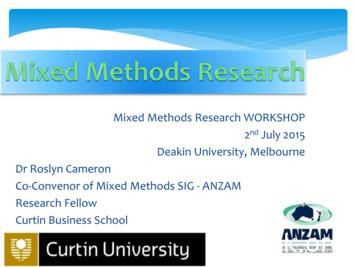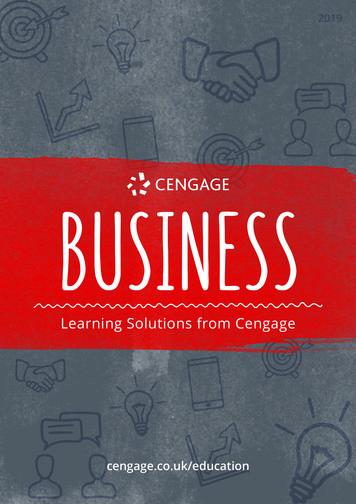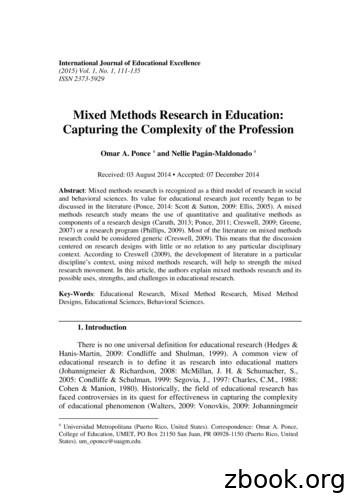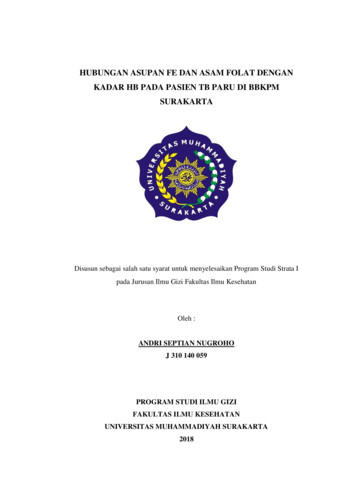Business Research Methods - Ramayah
ATW 202 –Business Research MethodsT. Ramayahramayah@usm.my, ramayah@gmail.comhttp://www.ramayah.comKami Memimpin We LeadKami Memimpin We Lead
ALWAYS LEARNINGSlide 2
ALWAYS LEARNINGSlide 3
ALWAYS LEARNING4Slide 4
ATW 202Business ResearchMethodsALWAYS LEARNINGSlide 5
General InformationLecturer:T. RamayahOffice:Room 019, Ext: 3416Lecture Hall:DK GTime/Date:Tuesday/2 - 4 pmConsultation:Monday 2 – 4 //www.ramayah.comGmail:ramayah@gmail.comALWAYS LEARNINGSlide 6
ALWAYS LEARNINGSlide 7
Course Outline/Teaching PlanALWAYS LEARNINGSlide 8
Synopsis This course is designed to introduce students to the research methodsthat can be used in most business research and other research related tothe social phenomenon. The areas that will be covered includes, introduction to the scientificmethod, research process, ethics in research, research design,measurement, sampling, data collection, analysis, interpretation andreport writing.ALWAYS LEARNINGSlide 9
Course Objectives1. To expose students to research methods in business2. To discuss the process of developing a research proposal3. Expose students to the various research designs that can be used inbusiness research4. To familiarize students with the choice of research designs that canbe used to achieve the proposed research5. To expose students to the various techniques that can be used toanalyse and interpret data in particular how to use SPSS software6. To expose students to the characteristics of a good research reportALWAYS LEARNINGSlide 10
Learning Outcomes1. To be able to explain the process of scientific research in business2. To be able to prepare a good research proposal3. To be able to identify the research designs that can be used in businessresearch4. To be able to pick the right research design to carry out the proposedresearch5. To know how to use SPSS in identifying the right techniques ofanalysis, analyse the data collected and interpret the data6. To be able to write a full research report.ALWAYS LEARNINGSlide 11
Main TextbookALWAYS LEARNINGSlide 12
ALWAYS LEARNINGSlide 13
ALWAYS LEARNINGSlide 14
Other References - Research1. Bell, E., Bryman, A. & Harley, A. (2018). Business Research Methods, USA: OxfordUniversity Press.2. Cavana, R. Y., Delahaye, B. L. & Uma Sekaran (2001). Applied Business Research:Qualitative and Quantitative, Australia: John Wiley & Sons.3. Hair, J. F., Page, M., & Brunsveld, N. (2020). Essentials of Business ResearchMethods, UK: Routledge.4. Saunders, M., Lewis, P. & Thornhill, A. (2019). Research Methods for BusinessStudents. Harlow: Pearson Education Limited.5. Salkind, N. J. (2019). Exploring Research. New Jersey, USA: Pearson Education Inc.6. Uma Sekaran & Bougie, R. (2016). Research Methods for Business: A Skill BuildingApproach. Seventh Edition. UK: John Wiley & Sons.7. Zikmund, W. G., Quinlan, C., Griffin, M., Babin, B. J., Carr, J. C. (2019). BusinessResearch Methods. Canada: South-Western, Cengage Learning.ALWAYS LEARNINGSlide 15
Other References - SPSS1. Field, A. (2018). Discovering Statistics using IBM SPSS Statistics. FifthEdition. USA: Sage Publications.2. George, D. & Mallery, P. (2019). IBM SPSS Statistics 23 Step by Step.A simple Guide and Reference. UK: Routledge.3. Pallant, J. (2016). SPSS Survival Manual, A step by step guide to dataanalysis using SPSS, NSW, Australia: Allen & Unwin.ALWAYS LEARNINGSlide 16
Other References - Statistics1. Berenson, M. L., Levine, Szabat, K. A., & Stephan, D. F. (2019). Basic BusinessStatistics: Concepts and Applications. New Jersey: Pearson Education, Inc.2. Hair, J. F., Black, B., Babin, B., Anderson, R. E., & Tatham, R. L. (2018). MultivariateData Analysis. Eighth Edition. UK: Cengage.3. Levin, R. I. & Rubin, D. S. (1998). Statistics for Management. USA: Prentice-HallInternational, Inc.4. Salkind, N. J. (2019). Statistics for People Who Think They Hate Statistics. UK: SAGEPublication.ALWAYS LEARNINGSlide 17
Research ProcessObservationIdentify ManagementTheory Refinement(Basic Research)DilemmaORImplementation(Applied Research)Theoretical FrameworkORNetwork of RelationshipsData Interpretationand Final ReportDataAnalysisHypothesisBab 15 - 20WritingBab 10 - 14Data Sources& CollectionALWAYS LEARNINGBab 6 - 9ConceptsConstructsOperational DefinitionsResearchDesignSlide 18
Week2TopicContentResearch in business(Schindler Chapter 1) Why study research?What is research?What are characteristics of a good research?3Thinking like a researcher(Schindler Chapter 1) Styles of thinkingThe thought processSources of KnowledgeUnderstanding Theory4The research process(Schindler Chapter 2) Research ProcessThe Management-Research question hierarchyResearch Process ProblemsDesigning the studyPurpose of the research proposalResearcher benefitsSponsors useTypes of research proposalsStructuring a researchEvaluating the research proposalWhat are research ethics?Ethical treatment of participantsEthics and the sponsorResearchers and the team membersProfessional standardsThe research proposal(Schindler Appendix a)Ethics in Business ResearchALWAYS LEARNINGSlide 19
4Clarifying the Research Questions(Schindler Chapter 3) Research ProcessThe Management-Research question hierarchyResearch Process ProblemsDesigning the study5Research design(Schindler Chapter 4) What is research design?Exploratory studiesDescriptive studiesCausal studies6Sampling(Schindler Chapter 5) The nature of samplingProbability samplingComplex probability samplingNon-probability samplingPractical considerations7Data Collection Design: Experiments(Cooper Schindler Chapter 8) What is Experimentation?Evaluation of ExperimentsConducting an ExperimentValidity in ExperimentsExperimental Research DesignsCharacteristics of communication approachCharacteristics of the communication approachPersonal interviewTelephone interviewSelf-administered surveysSelecting an optimal methodData Collection Design: The Survey(Schindler Chapter 9)ALWAYS LEARNINGSlide 20
8MID SEMESTER BREAK9MID TERM TEST10Measurement Questions(Schindler Chapter 11) Nature of measurementData typesSources of variation in measurementCharacteristics of a sound measurement11Measurement Questions(Schindler Chapter 11) Nature of measurement scalesResponse methodMeasurement scale construction12Measurement instruments(Schindler Chapter 12) Developing the instrument design strategyConstructing and refining the measurement questionsDrafting and refining the instrument13Collect, Prepare, and Examine Data(Schindler Chapter 13) Coding and EditingData EntryExploring, displaying and examining dataFrequency, descriptive statistics and contingency tablesALWAYS LEARNINGSlide 21
14Hypothesis testing(Schindler Chapter 14) 15Measures of Association(Schindler Chapter 15)1. Bivariate correlation analysis2. Bivariate regression analysis3. Multiple regression analysisReport Reports: Supported Insights andRecommendations(Schindler Chapter 16)4.5.6.7.8.ALWAYS LEARNINGHypothesis testingTests of significanceParametric test and Non-parametric testsThe written research reportComponents of a written research reportWriting a reportPresentation of statisticsOral presentationSlide 22
eLearn@USMALWAYS LEARNINGSlide 23
eLearn@USMALWAYS LEARNINGSlide 24
eLearn@USMALWAYS LEARNINGSlide 25
eLearn@USMALWAYS LEARNINGSlide 26
eLearn@USMALWAYS LEARNINGSlide 27
eLearn@USMALWAYS LEARNINGSlide 28
My Personal Web PageALWAYS LEARNINGSlide 29
ALWAYS LEARNINGSlide 30
My Personal Web PageALWAYS LEARNINGSlide 31
My Personal Web PageALWAYS LEARNINGSlide 32
My Personal Web PageALWAYS LEARNINGSlide 33
EvaluationMid Term Test20% Week 9(tentative) Chapter 1 – 4 60 questions objective, true/falseProject30% Submission date(Week 15) Form Group(1 – 5 persons)Final ExamALWAYS LEARNING50%Slide 34
Group Name ListNo.1NameAli AhmadMatric 5ALWAYS LEARNINGSlide 35
ProjectALWAYS LEARNINGSlide 36
Project DownloadALWAYS LEARNINGSlide 37
Project ContentALWAYS LEARNINGSlide 38
Project Notes FileALWAYS LEARNINGSlide 39
ProjectResearchResearch ModelModelALWAYS LEARNINGSlide 40
Project Questionnaire ItemsALWAYS LEARNINGSlide 41
ProjectQuestionnaireQuestionnaireALWAYS LEARNINGSlide 42
ProjectTemplateSPSS Data forEntryTemplateDataEntry - SPSSALWAYS LEARNINGSlide 43
VariableViewTemplatefor Data Entry - SPSSALWAYS LEARNINGSlide 44
Project GuidelinesALWAYS LEARNINGSlide 45
Research ProjectPerceivedusefulnessAttitudeEase ofuseIntentionUse WAYS LEARNINGSlide 46
Introduction Introduction should include support/justification “why” the researchshould be done. The focus is on the dependent variable of the study. Among the contents are: Problem statement Purpose of study Research objectives Research questions Definition of key variablesALWAYS LEARNINGSlide 47
Literature Review This section endeavors to convince the readers that the researcher hasreviewed other publications done before related to the topic/area. The focus of the search is on the dependent variable of the study. Among the contents are: Theory/theories General literature related to topic Specific General literature related to topic such as independent, moderating,mediating variables whichever relevant.ALWAYS LEARNINGSlide 48
Methodology This section describes the methodology used in carrying out theresearch. This section is very important technical wise. Among the contents are: Research model Hypotheses Variables and measurement Population, sample, sampling technique Data collection technique Techniques of analysis that may be usedALWAYS LEARNINGSlide 49
Data Analysis This section is important to test whatever hypotheses that has beendeveloped. Among the contents are: Sample profile (demographics) Factor analysis (not needed) Reliability analysis Descriptive table for the main variables of the study Hypotheses test related to the research framework Additional analysis to support the research findingsALWAYS LEARNINGSlide 50
Discussion & Conclusion This is the most important chapter which demonstrates whether you know what youare doing or not. Also a place to judge whether all your research questions have beenanswered. The discussion should be based on your findings and not what you think andyour prior experience. Among the contents are: The discussion of the main findings (Don’t discuss the statistics and p values just explain what isthe relationship and whether they exist) Implications for managers and theory Limitations Suggestions for future research (if ANY)ALWAYS LEARNINGSlide 51
Bibliography/References All references appearing in the text must be listed in the bibliography Also other references that the researcher has used but not cited in the textshould also be listed here. Format that should be followed is the “APA” format http://apastyle.apa.org/ https://capital.libguides.com/c.php?g 76089&p 6809978ALWAYS LEARNINGSlide 52
Appendices Important and relevant computer outputs. Paper cuttings or other relevant material Questionnaire (must be appended)ALWAYS LEARNINGSlide 53
PlagiarismAccording to the Merriam-Webster OnlineDictionary, to "plagiarize" means to steal and pass off (the ideas or words of another)as one's own to use (another's production) without crediting thesource to commit literary theft to present as new and original an idea or productderived from an existing source. In other words, plagiarism is an act of fraud. Itinvolves both stealing someone else's work andlying about it afterward.ALWAYS LEARNINGSlide 54
PlagiarismAll of the following are considered plagiarism: turning in someone else's work as your own copying words or ideas from someone else without giving credit failing to put a quotation in quotation marks giving incorrect information about the source of a quotation changing words but copying the sentence structure of a source without giving credit copying so many words or ideas from a source that it makes up the majority of your work, whether you give credit ornot (see our section on "fair use" rules)How to Avoid: Most cases of plagiarism can be avoided, however, by citing sources. Simply acknowledging that certain material hasbeen borrowed, and providing your audience with the information necessary to find that source, is usually enough toprevent plagiarism.ALWAYS LEARNINGSlide 55
ALWAYS LEARNINGSlide 56
ALWAYS LEARNINGSlide 57
TutorialsALWAYS LEARNINGSlide 58
MSN MessengerALWAYS LEARNINGSlide 59
Facebook Support GroupALWAYS LEARNINGSlide 60
FacebookSupport GroupFacebookPageALWAYS LEARNINGSlide 61
Expectation - Students1. read the relevant material prior to coming to class,2. have a list of questions you may want to ask in class,3. submit your work on time ,4. punctual for your classes,5. form your own groups,6. attend the class, unless unavoidable and switch off all hand-phonesduring classes.ALWAYS LEARNINGSlide 62
Expectation - Instructor1. ensure that the classes are conducted in a conducive manner for learning,2. be on time,3. minimize disruptions to schedule (unless unavoidable – I will endeavor toprovide sufficient notice of any cancellation),4. try to answer all your questions in a satisfactory manner,5. return you assignments/works in a timely manner,6. provide consultations for those who have problems following the course.ALWAYS LEARNINGSlide 63
USM Library – Research SupportALWAYS LEARNINGSlide 64
ALWAYS LEARNINGSlide 65
ALWAYS LEARNINGSlide 66
USM Library – Research SupportALWAYS LEARNINGSlide 67
USM Library – Research SupportALWAYS LEARNINGSlide 68
Please AttendALWAYS LEARNINGSlide 69
ALWAYS LEARNINGSlide 70
ALWAYS LEARNINGSlide 71
ALWAYS LEARNINGSlide 72
ALWAYS LEARNINGSlide 73
RememberIf you see me outside the classor in campus, please nod orgreet meALWAYS LEARNINGSlide 74
ALWAYS LEARNINGSlide 75
ALWAYS LEARNINGSlide 76
ALWAYS LEARNIN G Slide 9 Synopsis This course is designed to introduce students to the research methods that can be used in most business research and other research related to the social phenomenon. The areas that will be covered includes, introduction to the scientific method, research process, ethics in research, research des
University of Bradford, School of Management Introduction to Research Effective Learning Service 1 This workbook is a short introduction to research and research methods and will outline some, but not all, key areas of research and research methods: ¾ Definitions ¾ Research approaches ¾ Stages of the research process
Mixed Methods Research: Philosophy, Policy and Practice in Education (Vol. 7, Issue 1) Mixed Methods in Genders & Sexualities Research (Vol. 7, Issue 2) Mixed Methods in Education 2012 Vol 6 (3) Mixed Methods in Business & Management 2011 Vol5 (3) Mixed Methods in Health Sciences 2011 Vol 5 (1)
CONTENTS Introduction to Business 3 International Business 3 Corporate Governance 3 Business Law 4 Business Research Methods 4 Business Ethics 5 Business Economics/Accounting 5 Business Communication 5 Business Statistics/Decision Sciences 6 Business and Management Information Systems 7 Entrepreneurship and Small Business Management 8 Project Management 8 Operations Management/Supply Chain .
Exemplary Mixed Methods Research Studies Compiled by the Mixed Methods Working Group Funding provided by the Spencer Foundation* Our group addressed key features of successful mixed methods research; challenges of proposing and conducting such research; ways to address such challenges; training in mixed methods
medium-sized enterprises. The existing business valuation methods have been discussed in this research. In order to examine the accurate business valuation methods, a case study has been conducted, in which two case were studied. The results of the case study show that the DCF-methods are accurate business valuation methods.
A mixed methods research study means the use of quantitative and qualitative methods as components of a research design (Caruth, 2013; Ponce, 2011; Creswell, 2009; Greene, 2007) or a research program (Phillips, 2009). Most of the literature on mixed methods research could be considered generic (Creswell, 2009). This means that the discussion
1. Agile methods are undisciplined and not measurable. 2. Agile methods have no project management. 3. Agile methods apply only to software development. 4. Agile methods have no documentation. 5. Agile methods have no requirements. 6. Agile methods only work with small colocated teams.-7. Agile methods do not include planning. 8.
hubungan antara asupan asam folat dengan kadar Hb dengan nilai p 0,64. Kata Kunci : asupan fe, asupan folat, kadar hb, tb paru . Abstract . Tuberculosis pulmonary can lead to various metabolic disorders and system disturbances in the body, one of which is synthetic disorder of Hemoglobin levels. Some nutrients which can influence the synthetic of Hemoglobin levels are iron (Fe) and folic .























